Understanding the Impact of the COVID-19 Pandemic on the Perception and Use of Urban Green Spaces in Korea
Abstract
1. Introduction
1.1. Urban Green Space as the Source of Ecosystem Services
1.2. The COVID-19 and UGS
1.3. Understanding Users’ Perception for Landscape Planning
1.4. Aim and Theoretical Framework
2. Materials and Method
2.1. Study Area
2.2. Method
2.2.1. Research Design and Process
2.2.2. Questionnaire
2.2.3. Survey Analysis and Visualization
3. Results
3.1. Respondents’ Profile
3.2. The Awareness of UGS
3.3. The Change in UGS Utilization
4. Discussions
5. Conclusions
Author Contributions
Funding
Institutional Review Board Statement
Informed Consent Statement
Data Availability Statement
Conflicts of Interest
References
- Sanesi, G.; Chiarello, F. Residents and Urban Green Spaces: The Case of Bari. Urban For. Urban Green. 2006, 4, 125–134. [Google Scholar]
- Liu, S.; Zhang, X.; Feng, Y.; Xie, H.; Jiang, L.; Lei, Z. Spatiotemporal Dynamics of Urban Green Space Influenced by Rapid Urbanization and Land Use Policies in Shanghai. Forests 2021, 12, 476. [Google Scholar] [CrossRef]
- UNDP. Peoples’ Climate Vote; United Nation Development Programme: New York, NY, USA, 2021; pp. 1–67. [Google Scholar]
- Feltynowski, M.; Kronenberg, J. Urban Green Spaces—An Underestimated Resource in Third-Tier Towns in Poland. Land 2020, 9, 453. [Google Scholar]
- Costanza, R.; D’Arge, R.; De Groot, R.; Farber, S.; Grasso, M.; Hannon, B.; Limburg, K.; Naeem, S.; O’Neill, R.V.; Paruelo, J.; et al. The Value of the World’s Ecosystem Services and Natural Capital. Nature 1997, 387, 253–260. [Google Scholar] [CrossRef]
- Chen, W.Y.; Jim, C.Y. Assessment and Valuation of the Ecosystem Services Provided by Urban Forests. In Ecology, Planning, and Management of Urban Forests; Springer: New York, NY, USA, 2008; pp. 53–83. [Google Scholar]
- Xie, H.; Zhang, Y.; Zeng, X.; He, Y. Sustainable Land Use and Management Research: A Scientometric Review. Landsc. Ecol. 2020, 35, 2381–2411. [Google Scholar] [CrossRef]
- Baró, F.; Chaparro, L.; Gómez-Baggethun, E.; Langemeyer, J.; Nowak, D.J.; Terradas, J. Contribution of Ecosystem Services to Air Quality and Climate Change Mitigation Policies: The Case of Urban Forests in Barcelona, Spain. In Urban Forests, 1st ed.; Apple Academic Press: Palm Bay, FL, USA, 2016; p. 34. [Google Scholar]
- Nowak, D.J.; Crane, D.E.; Stevens, J.C. Air Pollution Removal by Urban Trees and Shrubs in the United States. Urban For. Urban Green. 2006, 4, 115–123. [Google Scholar] [CrossRef]
- Bolund, P.; Hunhammar, S. Ecosystem Services in Urban Areas. Ecol. Econ. 1999, 29, 293–301. [Google Scholar] [CrossRef]
- Seeland, K.; Dübendorfer, S.; Hansmann, R. Making Friends in Zurich’s Urban Forests and Parks: The Role of Public Green Space for Social Inclusion of Youths from Different Cultures. For. Policy Econ. 2009, 11, 10–17. [Google Scholar]
- Kim, J.; Kaplan, R. Physical and Psychological Factors in Sense of Community: New Urbanist Kentlands and Nearby Orchard Village. Environ. Behav. 2004, 36, 313–340. [Google Scholar]
- Lee, A.C.K.; Jordan, H.C.; Horsley, J. Value of Urban Green Spaces in Promoting Healthy Living and Wellbeing: Prospects for Planning. Risk Manag. Healthc. Policy 2015, 8, 131. [Google Scholar]
- Hedblom, M.; Gunnarsson, B.; Iravani, B.; Knez, I.; Schaefer, M.; Thorsson, P.; Lundström, J.N. Reduction of Physiological Stress by Urban Green Space in a Multisensory Virtual Experiment. Sci. Rep. 2019, 9, 10113. [Google Scholar] [CrossRef]
- Lotfi, M.; Hamblin, M.R.; Rezaei, N. COVID-19: Transmission, Prevention, and Potential Therapeutic Opportunities. Clin. Chim. Acta 2020, 508, 254–266. [Google Scholar]
- Kamga, C.; Eickemeyer, P. Slowing the Spread of COVID-19: Review of “Social Distancing” Interventions Deployed by Public Transit in the United States and Canada. Transp. Policy 2021, 106, 25–36. [Google Scholar] [CrossRef]
- Collins, C.; Haase, D.; Heiland, S.; Kabisch, N. Urban Green Space Interaction and Wellbeing–Investigating the Experience of International Students in Berlin during the First COVID-19 Lockdown. Urban For. Urban Green. 2022, 70, 127543. [Google Scholar]
- Ugolini, F.; Massetti, L.; Pearlmutter, D.; Sanesi, G. Usage of Urban Green Space and Related Feelings of Deprivation during the COVID-19 Lockdown: Lessons Learned from an Italian Case Study. Land Use Policy 2021, 105, 105437. [Google Scholar]
- Mayen Huerta, C.; Cafagna, G. Snapshot of the Use of Urban Green Spaces in Mexico City during the COVID-19 Pandemic: A Qualitative Study. Int. J. Environ. Res. Public Health 2021, 18, 4304. [Google Scholar] [CrossRef]
- Ugolini, F.; Massetti, L.; Calaza-Martínez, P.; Cariñanos, P.; Dobbs, C.; Ostoic, S.K.; Marin, A.M.; Pearlmutter, D.; Saaroni, H.; Šaulienė, I.; et al. Effects of the COVID-19 Pandemic on the Use and Perceptions of Urban Green Space: An International Exploratory Study. Urban For. Urban Green. 2020, 56, 126888. [Google Scholar]
- Rook, G.A. Regulation of the Immune System by Biodiversity from the Natural Environment: An Ecosystem Service Essential to Health. Proc. Natl. Acad. Sci. USA 2013, 110, 18360–18367. [Google Scholar]
- Shi, Y.; Wang, Y.; Shao, C.; Huang, J.; Gan, J.; Huang, X.; Bucci, E.; Piacentini, M.; Ippolito, G.; Melino, G. COVID-19 Infection: The Perspectives on Immune Responses. Cell Death Differ. 2020, 27, 1451–1454. [Google Scholar]
- Gim, T.H.T. The Corona Blues According to Daily Life Changes by COVID-19: A Partial Least Squares Regression Model. Growth Chang. 2022.
- Cervantes, O.; Espejel, I.; Arellano, E.; Delhumeau, S. Users’ Perception as a Tool to Improve Urban Beach Planning and Management. Environ. Manage. 2008, 42, 249–264. [Google Scholar]
- Pickens, J. Attitudes and Perceptions. Organ. Behav. Health care 2005, 4, 43–76. [Google Scholar]
- Osborne, S. Public Service Logic: Creating Value for Public Service Users, Citizens, and Society through Public Service Delivery; Routledge: Abingdon-on-Thames, UK, 2020. [Google Scholar]
- Pollitt, C.; Bouckaert, G. Public Management Reform: A Comparative Analysis-into the Age of Austerity; Oxford University Press: Oxford, UK, 2017. [Google Scholar]
- Osborne, S.P. Introduction The (New) Public Governance: A Suitable Case for Treatment? In The New Public Governance? Taylor and Francis: Abingdon, UK, 2009; pp. 1–16. [Google Scholar]
- Uslu, A.; Kiper, T.; Baris, M.E. Public Health—Urban Landscaping Relationship and User’s Perceptions. Biotechnol. Biotechnol. Equip. 2014, 23, 1399–1408. [Google Scholar]
- Camacho-Cervantes, M.; Schondube, J.E.; Castillo, A.; MacGregor-Fors, I. How Do People Perceive Urban Trees? Assessing Likes and Dislikes in Relation to the Trees of a City. Urban Ecosyst. 2014, 17, 761–773. [Google Scholar]
- Bonnes, M.; Passafaro, P.; Carrus, G. The Ambivalence of Attitudes toward Urban Green Areas: Between Proenvironmental Worldviews and Daily Residential Experience. Env. Behav 2011, 43, 207–232. [Google Scholar] [CrossRef]
- Luo, S.; Xie, J.; Furuya, K. “We Need Such a Space”: Residents’ Motives for Visiting Urban Green Spaces during the COVID-19 Pandemic. Sustainability 2021, 13, 6806. [Google Scholar]
- De Luca, C.; Libetta, A.; Conticelli, E.; Tondelli, S. Accessibility to and Availability of Urban Green Spaces (UGS) to Support Health and Wellbeing during the COVID-19 Pandemic—The Case of Bologna. Sustainability 2021, 13, 11054. [Google Scholar] [CrossRef]
- Yap, K.K.; Soh, M.C.; Sia, A.; Chin, W.J.; Araib, S.; Ang, W.P.; Tan, P.Y.; Er, K.B. The Influence of the COVID-19 Pandemic on the Demand for Different Shades of Green; Wiley Online Library: Hoboken, NJ, USA, 2022; Volume 4, pp. 505–518. [Google Scholar]
- Marconi, P.L.; Perelman, P.E.; Salgado, V.G. Green in Times of COVID-19: Urban Green Space Relevance during the COVID-19 Pandemic in Buenos Aires City. Urban Ecosyst. 2022, 25, 941–953. [Google Scholar] [CrossRef]
- Sikorska, D.; Wojnowska-Heciak, M.; Heciak, J.; Bukowska, J.; Łaszkiewicz, E.; Sikorski, P. How Urban Green Spaces Need to Change to Address the Public Post-Covid Expectations. SSRN Electron. J. 2022. [CrossRef]
- Noszczyk, T.; Gorzelany, J.; Kukulska-Kozieł, A.; Hernik, J. The Impact of the COVID-19 Pandemic on the Importance of Urban Green Spaces to the Public. Land Use Policy 2022, 113, 105925. [Google Scholar]
- Lopez, B.; Kennedy, C.; Field, C.; McPhearson, T. Who Benefits from Urban Green Spaces during Times of Crisis? Perception and Use of Urban Green Spaces in New York City during the COVID-19 Pandemic. Urban For. Urban Green. 2021, 65, 127354. [Google Scholar] [CrossRef]
- Yamazaki, T.; Iida, A.; Hino, K.; Murayama, A.; Hiroi, U.; Terada, T.; Koizumi, H.; Yokohari, M. Use of Urban Green Spaces in the Context of Lifestyle Changes during the COVID-19 Pandemic in Tokyo. Sustainability 2021, 13, 9817. [Google Scholar]
- Reyes-Riveros, R.; Altamirano, A.; De La Barrera, F.; Rozas-Vásquez, D.; Vieli, L.; Meli, P. Linking Public Urban Green Spaces and Human Well-Being: A Systematic Review. Urban For. Urban Green. 2021, 61, 127105. [Google Scholar]
- Ding, A.; Cenci, J.; Zhang, J. Links between the Pandemic and Urban Green Spaces, a Perspective on Spatial Indices of Landscape Garden Cities in China. Sustain. Cities Soc. 2022, 85, 104046. [Google Scholar] [CrossRef]
- Choi, J. Instabilities in the Korean Urban Population Growth. J. Korean Urban Geogr. Soc. 2010, 13, 89–102. [Google Scholar]
- Joo, Y.-M. Megacity Seoul, 1st ed.; Routledge: London, UK, 2018; pp. 1–156. [Google Scholar]
- Song, W.; Kim, E. Landscape Factors Affecting the Distribution of the Great Tit in Fragmented Urban Forests of Seoul, South Korea. Landsc. Ecol. Eng. 2016, 12, 73–83. [Google Scholar]
- Lee, J.; Yoon, T.K.; Han, S.; Kim, S.; Yi, M.J.; Park, G.S.; Kim, C.; Son, Y.M.; Kim, R.; Son, Y. Estimating the Carbon Dynamics of South Korean Forests from 1954 to 2012. Biogeosciences 2014, 11, 4637–4650. [Google Scholar] [CrossRef]
- KFS. Report on a Survey on Public Awareness to Forests; Korea Forest Service: Deajeon, Republic of Korea, 2015.
- Semenza, J.C.; Hall, D.E.; Wilson, D.J.; Bontempo, B.D.; Sailor, D.J.; George, L.A. Public Perception of Climate Change: Voluntary Mitigation and Barriers to Behavior Change. Am. J. Prev. Med. 2008, 35, 479–487. [Google Scholar]
- Hathaway, J.; Maibach, E.W. Health Implications of Climate Change: A Review of the Literature About the Perception of the Public and Health Professionals. Curr. Environ. Health Rep. 2018, 5, 197–204. [Google Scholar] [CrossRef]
- Ratter, B.M.W.; Philipp, K.H.I.; Von Storch, H. Between Hype and Decline: Recent Trends in Public Perception of Climate Change. Environ. Sci. Policy 2012, 18, 3–8. [Google Scholar] [CrossRef]
- Collins, C.M.T.; Cook-Monie, I.; Raum, S. What Do People Know? Ecosystem Services, Public Perception and Sustainable Management of Urban Park Trees in London, U.K. Urban For. Urban Green. 2019, 43, 126362. [Google Scholar] [CrossRef]
- Qureshi, S.; Hasan Kazmi, S.J.; Breuste, J.H. Ecological Disturbances Due to High Cutback in the Green Infrastructure of Karachi: Analyses of Public Perception about Associated Health Problems. Urban For. Urban Green. 2010, 9, 187–198. [Google Scholar]
- Haq, S.M.A. Urban Green Spaces and an Integrative Approach to Sustainable Environment. J. Environ. Prot. 2011, 2, 601–608. [Google Scholar]
- Taylor, A.F.; Wiley, A.; Kuo, F.E.; Sullivan, W.C. Growing up in the inner city: Green spaces as places to grow. Environ. Behav. 1998, 30, 3–27. [Google Scholar] [CrossRef]
- Bierzychudek, P. Looking Backwards: Assessing The Projections Of A Transition Matrix Model. Ecol. Appl. 1999, 9, 1278–1287. [Google Scholar]
- Hernández-López, M.; Cáceres-Hernández, J.J. Forecasting Tourists’ Characteristics by a Genetic Algorithm with a Transition Matrix. Tour. Manag. 2007, 28, 290–297. [Google Scholar]
- Comber, A.; Balzter, H.; Cole, B.; Fisher, P.; Johnson, S.C.M.; Ogutu, B. Methods to Quantify Regional Differences in Land Cover Change. Remote Sens. 2016, 8, 176. [Google Scholar]
- Lee, N.; Ridder, G.; Strauss, J. Estimation of Poverty Transition Matrices with Noisy Data. J. Appl. Econom. 2017, 32, 37–55. [Google Scholar] [CrossRef]
- Wood, L.; Hooper, P.; Foster, S.; Bull, F. Public Green Spaces and Positive Mental Health–Investigating the Relationship between Access, Quantity and Types of Parks and Mental Wellbeing. Health Place 2017, 48, 63–71. [Google Scholar]
- Uchiyama, Y.; Kohsaka, R. Access and Use of Green Areas during the COVID-19 Pandemic: Green Infrastructure Management in the “New Normal. ” Sustainability 2020, 12, 9842. [Google Scholar] [CrossRef]
- Fernández-Abascal, E.G.; Martín-Díaz, M.D. Longitudinal Study on Affect, Psychological Well-Being, Depression, Mental and Physical Health, Prior to and during the COVID-19 Pandemic in Spain. Pers. Individ. Dif. 2021, 172, 110591. [Google Scholar] [CrossRef]
- Carriedo, A.; Cecchini, J.A.; Fernandez-Rio, J.; Méndez-Giménez, A. COVID-19, Psychological Well-Being and Physical Activity Levels in Older Adults During the Nationwide Lockdown in Spain. Am. J. Geriatr. Psychiatry 2020, 28, 1146–1155. [Google Scholar]
- Agha, S. Mental Well-Being and Association of the Four Factors Coping Structure Model: A Perspective of People Living in Lockdown during COVID-19. Ethics Med. Public Health 2021, 16, 100605. [Google Scholar]
- Lippi, G.; Henry, B.M. Chronic Obstructive Pulmonary Disease Is Associated with Severe Coronavirus Disease 2019 (COVID-19). Respir. Med. 2020, 167, 105941. [Google Scholar]
- Beltramo, G.; Cottenet, J.; Mariet, A.S.; Georges, M.; Piroth, L.; Tubert-Bitter, P.; Bonniaud, P.; Quantin, C. Chronic Respiratory Diseases Are Predictors of Severe Outcome in COVID-19 Hospitalised Patients: A Nationwide Study. Eur. Respir. J. 2021, 58, 2004474. [Google Scholar] [CrossRef]
- Okruszek, Ł.; Aniszewska-Stańczuk, A.; Piejka, A.; Wiśniewska, M.; Żurek, K. Safe but Lonely? Loneliness, Anxiety, and Depression Symptoms and COVID-19. Front. Psychol. 2020, 11, 3222. [Google Scholar]
- Boursier, V.; Gioia, F.; Musetti, A.; Schimmenti, A. Facing Loneliness and Anxiety During the COVID-19 Isolation: The Role of Excessive Social Media Use in a Sample of Italian Adults. Front. Psychiatry 2020, 11, 1380. [Google Scholar] [CrossRef]
- Palgi, Y.; Shrira, A.; Ring, L.; Bodner, E.; Avidor, S.; Bergman, Y.; Cohen-Fridel, S.; Keisari, S.; Hoffman, Y. The Loneliness Pandemic: Loneliness and Other Concomitants of Depression, Anxiety and Their Comorbidity during the COVID-19 Outbreak. J. Affect. Disord. 2020, 275, 109–111. [Google Scholar] [CrossRef]
- Blustein, D.L.; Duffy, R.; Ferreira, J.A.; Cohen-Scali, V.; Cinamon, R.G.; Allan, B.A. Unemployment in the Time of COVID-19: A Research Agenda. J. Vocat. Behav. 2020, 119, 103436. [Google Scholar] [CrossRef]
- Kawohl, W.; Nordt, C. COVID-19, Unemployment, and Suicide. The Lancet Psychiatry 2020, 7, 389–390. [Google Scholar] [CrossRef]
- Kang, M.; Choi, Y.; Kim, J.; Lee, K.O.; Lee, S.; Park, I.K.; Park, J.; Seo, I. COVID-19 Impact on City and Region: What’s next after Lockdown? Int. J. Urban Sci. 2020, 24, 297–315. [Google Scholar] [CrossRef]
- Park, S.H.; Chang, C. Impact of Changes in Forest Use Caused by the COVID-19 Pandemic on the Perception of Forest Ecosystem Services in the Republic of Korea. Sustainability 2022, 14, 10914. [Google Scholar] [CrossRef]
- Derkzen, M.L.; van Teeffelen, A.J.A.; Verburg, P.H. REVIEW: Quantifying Urban Ecosystem Services Based on High-Resolution Data of Urban Green Space: An Assessment for Rotterdam, the Netherlands. J. Appl. Ecol. 2015, 52, 1020–1032. [Google Scholar] [CrossRef]
- Kabisch, N.; Frantzeskaki, N.; Pauleit, S.; Naumann, S.; McKenna, D.; Artmann, M.; Haase, D.; Knapp, S.; Korn, H.; Stadler, J.; et al. Nature-Based Solutions to Climate Change Mitigation and Adaptation in Urban Areas Perspectives on Indicators, Knowledge Gaps, Barriers, and Opportunities for Action. Ecol. Soc. 2016, 21, 39. [Google Scholar]
- Berdejo-Espinola, V.; Suárez-Castro, A.F.; Amano, T.; Fielding, K.S.; Oh, R.R.Y.; Fuller, R.A. Urban Green Space Use during a Time of Stress: A Case Study during the COVID-19 Pandemic in Brisbane, Australia. People Nat. 2021, 3, 597–609. [Google Scholar]
- Diener, A.; Mudu, P. How Can Vegetation Protect Us from Air Pollution? A Critical Review on Green Spaces’ Mitigation Abilities for Air-Borne Particles from a Public Health Perspective-with Implications for Urban Planning. Sci. Total Environ. 2021, 796, 148605. [Google Scholar]
- Kolimenakis, A.; Solomou, A.D.; Proutsos, N.; Avramidou, E.V.; Korakaki, E.; Karetsos, G.; Kontogianni, A.B.; Kontos, K.; Georgiadis, C.; Maroulis, G.; et al. Public Perceptions of the Socioeconomic Importance of Urban Green Areas in the Era of COVID-19: A Case Study of a Nationwide Survey in Greece. Land 2022, 11, 2290. [Google Scholar] [CrossRef]
- Larcher, F.; Pomatto, E.; Battisti, L.; Gullino, P.; Devecchi, M. Perceptions of Urban Green Areas during the Social Distancing Period for COVID-19 Containment in Italy. Horticulturae 2021, 7, 55. [Google Scholar] [CrossRef]
- Wen, C.; Albert, C.; von Haaren, C. Nature-Based Recreation for the Elderly in Urban Areas: Assessing Opportunities and Demand as Planning Support. Ecol. Process. 2022, 11, 1–17. [Google Scholar]
- Włodarczyk-Marciniak, R.; Sikorska, D.; Krauze, K. Residents’ Awareness of the Role of Informal Green Spaces in a Post-Industrial City, with a Focus on Regulating Services and Urban Adaptation Potential. Sustain. Cities Soc. 2020, 59, 102236. [Google Scholar] [CrossRef]
- Vidal, D.G.; Fernandes, C.O.; Teixeira, C.P.; Dias, R.C.; Seixas, P.C.; Barros, N.; Vilaça, H.; Maia, R.L. Behavioural Mapping of Urban Green Spaces Users: Methodological Procedures Applied to Corujeira Garden (Porto, Portugal). World Sustain. Ser. 2022, 147–166. [Google Scholar]
- Artmann, M.; Chen, X.; Iojă, C.; Hof, A.; Onose, D.; Poniży, L.; Lamovšek, A.Z.; Breuste, J. The Role of Urban Green Spaces in Care Facilities for Elderly People across European Cities. Urban For. Urban Green. 2017, 27, 203–213. [Google Scholar] [CrossRef]
- Niemelä, J.; Saarela, S.R.; Söderman, T.; Kopperoinen, L.; Yli-Pelkonen, V.; Väre, S.; Kotze, D.J. Using the Ecosystem Services Approach for Better Planning and Conservation of Urban Green Spaces: A Finland Case Study. Biodivers. Conserv. 2010, 19, 3225–3243. [Google Scholar]
- Ye, C.; Hu, L.; Li, M. Urban Green Space Accessibility Changes in a High-Density City: A Case Study of Macau from 2010 to 2015. J. Transp. Geogr. 2018, 66, 106–115. [Google Scholar]
- Jim, C.Y.; Chen, W.Y. Perception and Attitude of Residents toward Urban Green Spaces in Guangzhou (China). Environ. Manag. 2006, 38, 338–349. [Google Scholar]
- Lin, H.H.; Ling, Y.; Lin, J.C.; Liang, Z.F. Research on the Development of Religious Tourism and the Sustainable Development of Rural Environment and Health. Int. J. Environ. Res. Public Health 2021, 18, 2731. [Google Scholar] [CrossRef]
- Haynes, A.; Robinson, E. Who Are We Testing? Self-Selection Bias in Laboratory-Based Eating Behaviour Studies. Appetite 2019, 141, 104330. [Google Scholar] [CrossRef]
- Smironva, E.; Kiatkawsin, K.; Lee, S.K.; Kim, J.; Lee, C.H. Self-Selection and Non-Response Biases in Customers’ Hotel Ratings—A Comparison of Online and Offline Ratings. Curr. Issues Tour. 2019, 23, 1191–1204. [Google Scholar] [CrossRef]
- Sung, H.; Kim, W.R.; Oh, J.; Lee, S.; Lee, P.S.H. Are All Urban Parks Robust to the COVID-19 Pandemic? Focusing on Type, Functionality, and Accessibility. Int. J. Environ. Res. Public Health 2022, 19, 6062. [Google Scholar] [CrossRef]
- Chen, L.; Liu, L.; Wu, H.; Peng, Z.; Sun, Z. Change of Residents’ Attitudes and Behaviors toward Urban Green Space Pre- and Post- COVID-19 Pandemic. Land 2022, 11, 1051. [Google Scholar]
- Honey-Rosés, J.; Anguelovski, I.; Chireh, V.K.; Daher, C.; Konijnendijk van den Bosch, C.; Litt, J.S.; Mawani, V.; McCall, M.K.; Orellana, A.; Oscilowicz, E.; et al. The Impact of COVID-19 on Public Space: An Early Review of the Emerging Questions–Design, Perceptions and Inequities. Cities Health 2020, 5, S263–S279. [Google Scholar]
- Palliwoda, J.; Priess, J.A. What Do People Value in Urban Green? Linking Characteristics of Urban Green Spaces to Users’ Perceptions of Nature Benefits, Disturbances, and Disservices. Ecol. Soc. Publ. 2021, 26, 28. [Google Scholar]
- Pinto, L.V.; Inácio, M.; Ferreira, C.S.S.; Ferreira, A.D.; Pereira, P. Ecosystem Services and Well-Being Dimensions Related to Urban Green Spaces—A Systematic Review. Sustain. Cities Soc. 2022, 85, 104072. [Google Scholar] [CrossRef]
- MOLIT. Cadastral Statistical Annual Report; Ministry of Land, Infrastructure and Transport: Sejong, Republic of Korea, 2021.
- Hong, S. Analysis on Greenhouse Gas Emissions and Absorption in Settlements for Management of Carbon Sink-In Case of Sejong City; Korea University: Seoul, Republic of Korea, 2022. [Google Scholar]
- Liu, F.; Tian, Y.; Jim, C.; Wang, T.; Luan, J.; Yan, M. Residents’ Living Environments, Self-Rated Health Status and Perceptions of Urban Green Space Benefits. Forest 2022, 13, 9. [Google Scholar]
- Christoforidi, I.; Kollaros, D.; Papadakaki, M.; Psaroudaki, A.; Antoniou, T.; Daliakopoulos, I.N. A Novel Index for Assessing Perceived Availability and Public Demand for Urban Green Space: Application in a Mediterranean Island. Urban For. Urban Green. 2022, 69, 127498. [Google Scholar] [CrossRef]
- Zhang, L.; Tan, P.Y.; Richards, D. Relative Importance of Quantitative and Qualitative Aspects of Urban Green Spaces in Promoting Health. Landsc. Urban Plan. 2021, 213, 104131. [Google Scholar]
- Pinto, L.; Ferreira, C.S.S.; Pereira, P. Environmental and Socioeconomic Factors Influencing the Use of Urban Green Spaces in Coimbra (Portugal). Sci. Total Environ. 2021, 792, 148293. [Google Scholar] [CrossRef]
- Salvia, G.; Pluchinotta, I.; Tsoulou, I.; Moore, G.; Zimmermann, N. Understanding Urban Green Space Usage through Systems Thinking: A Case Study in Thamesmead, London. Sustainability 2022, 14, 2575. [Google Scholar]
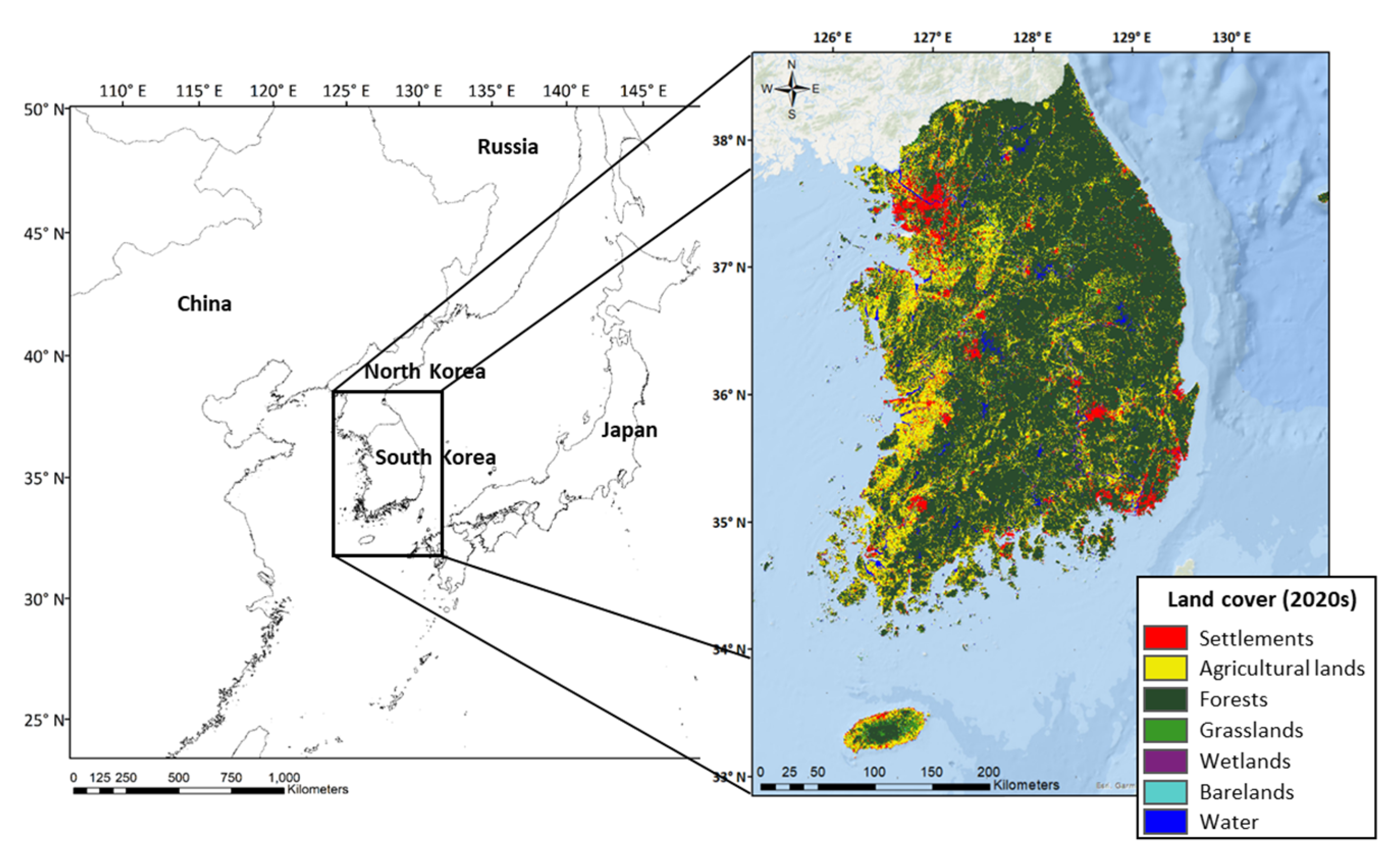
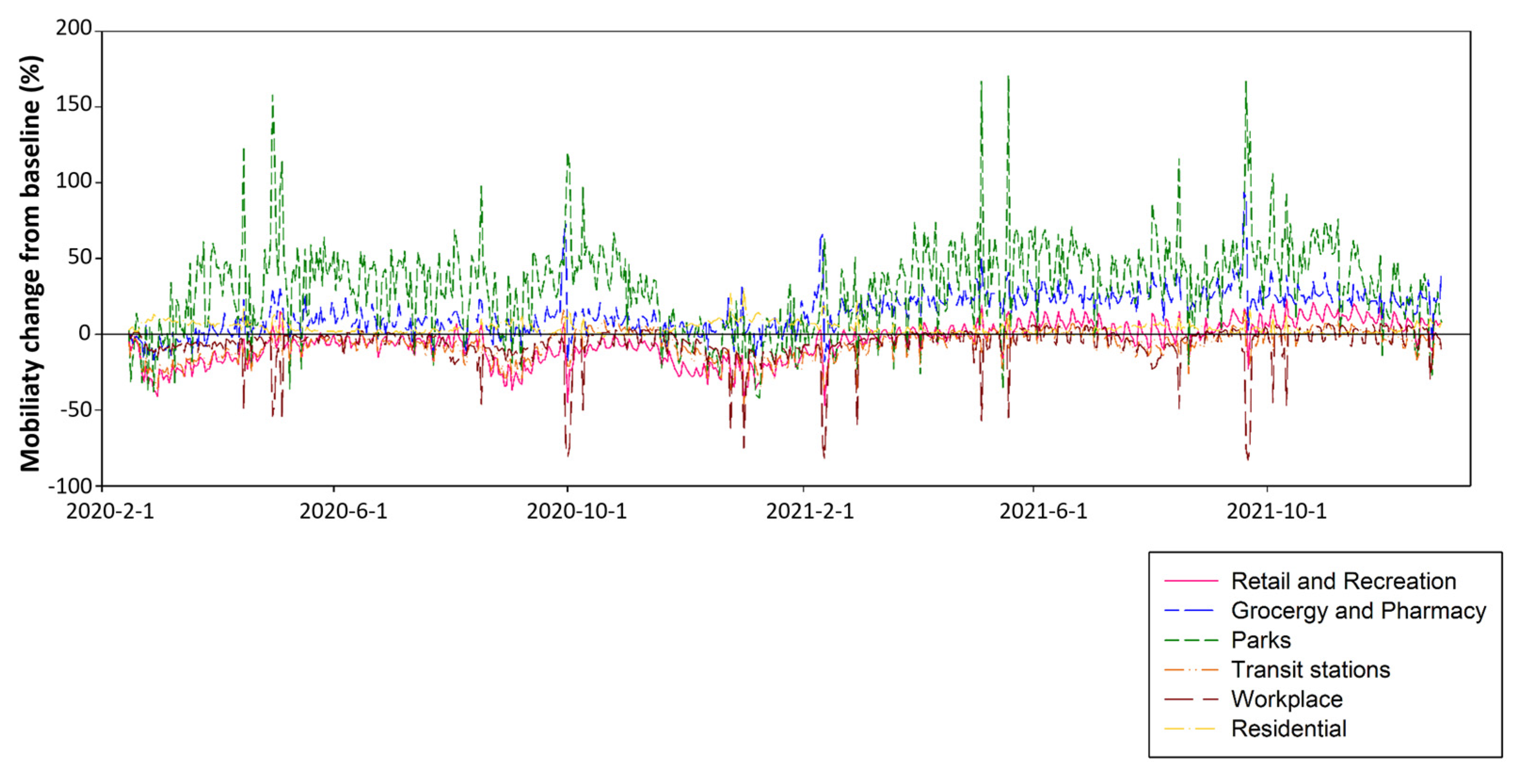
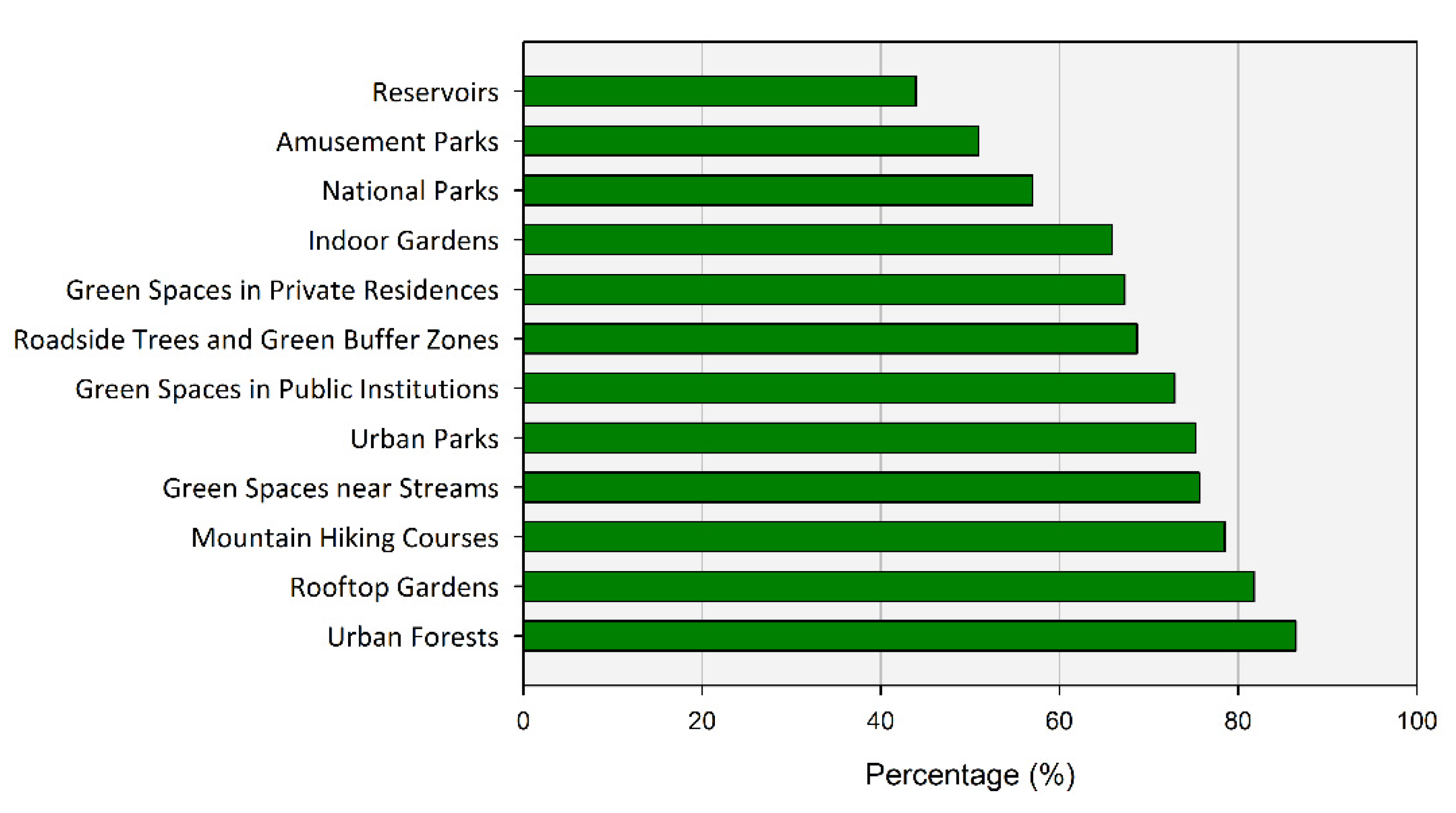
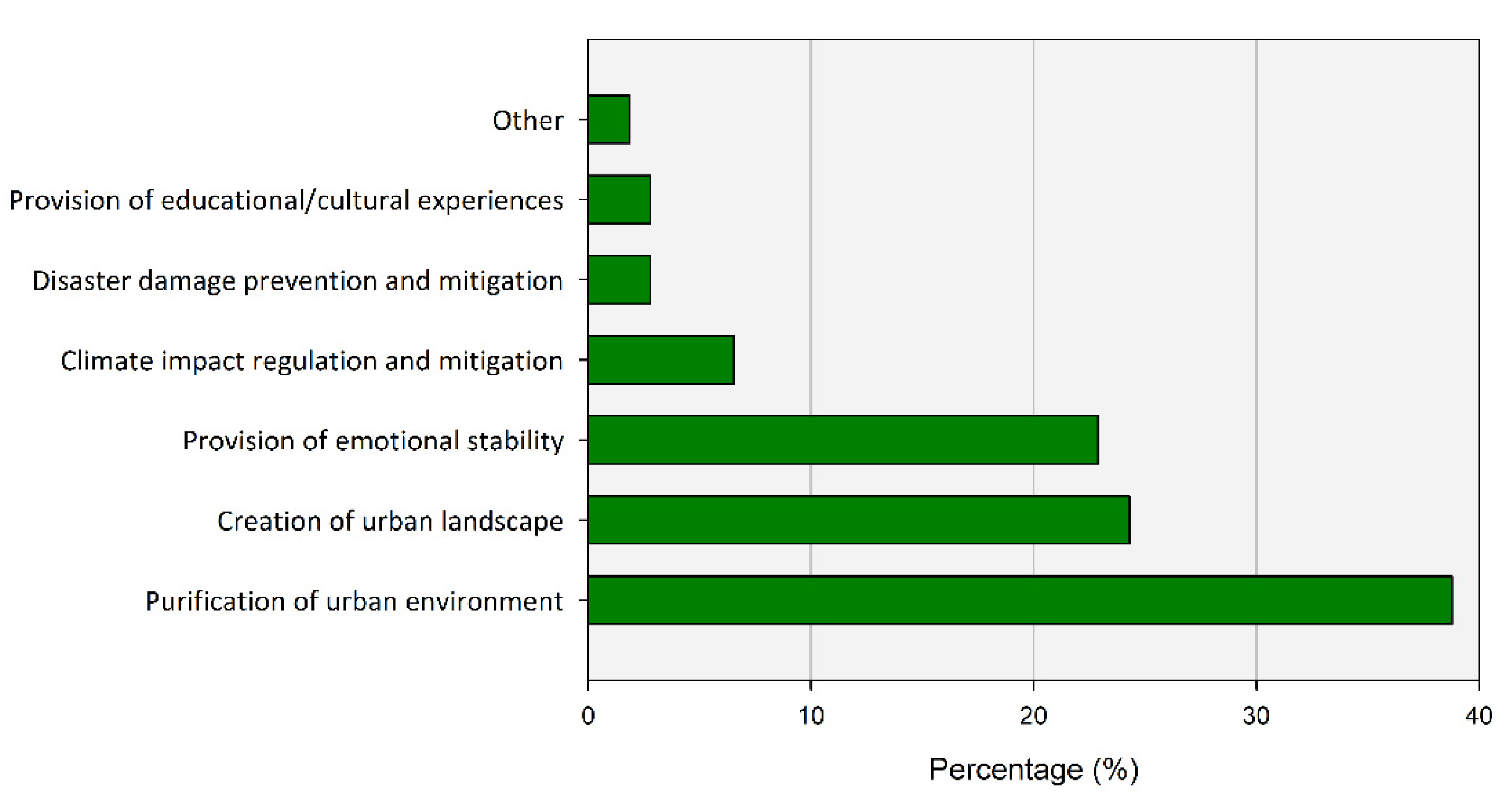
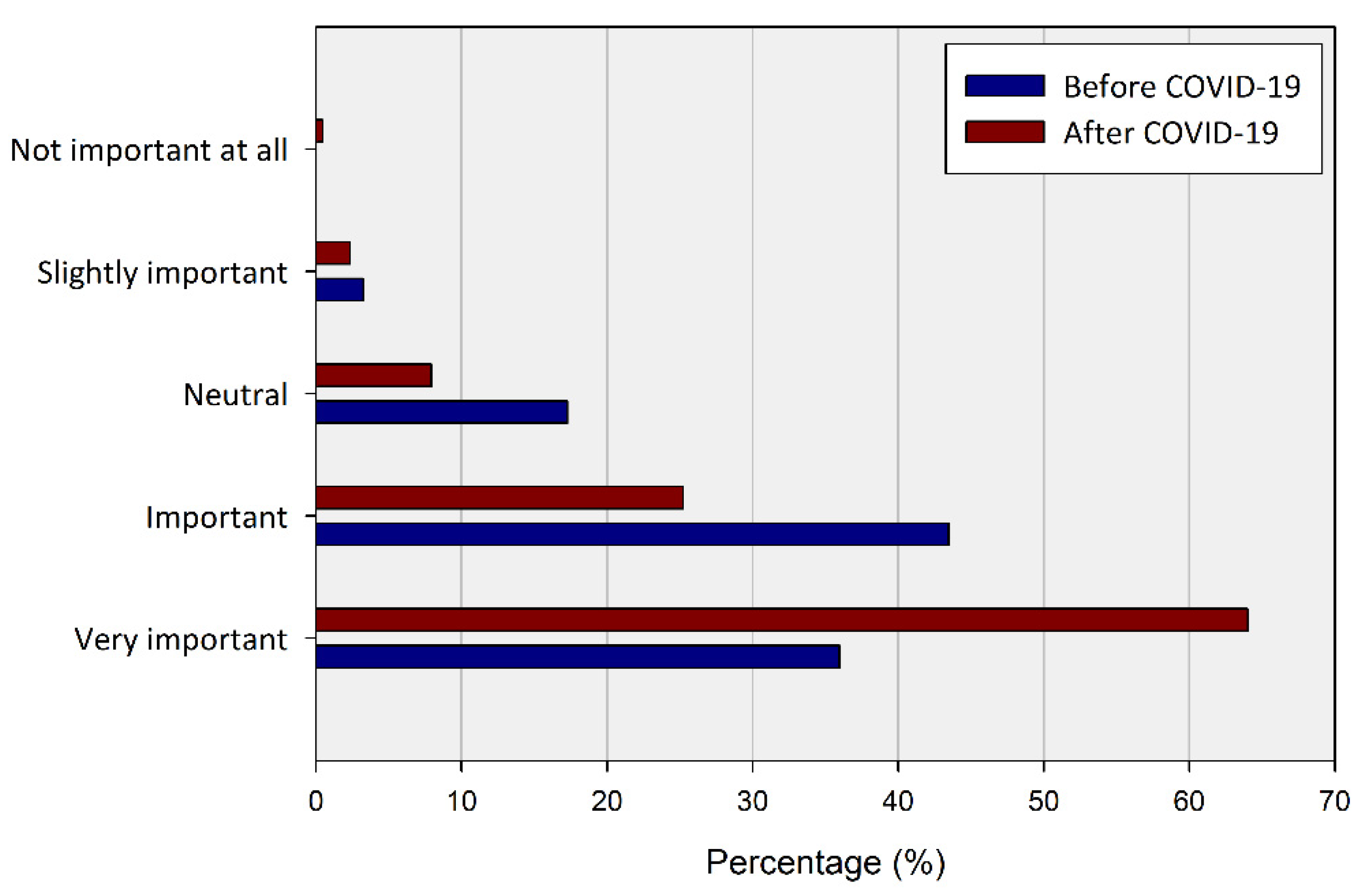
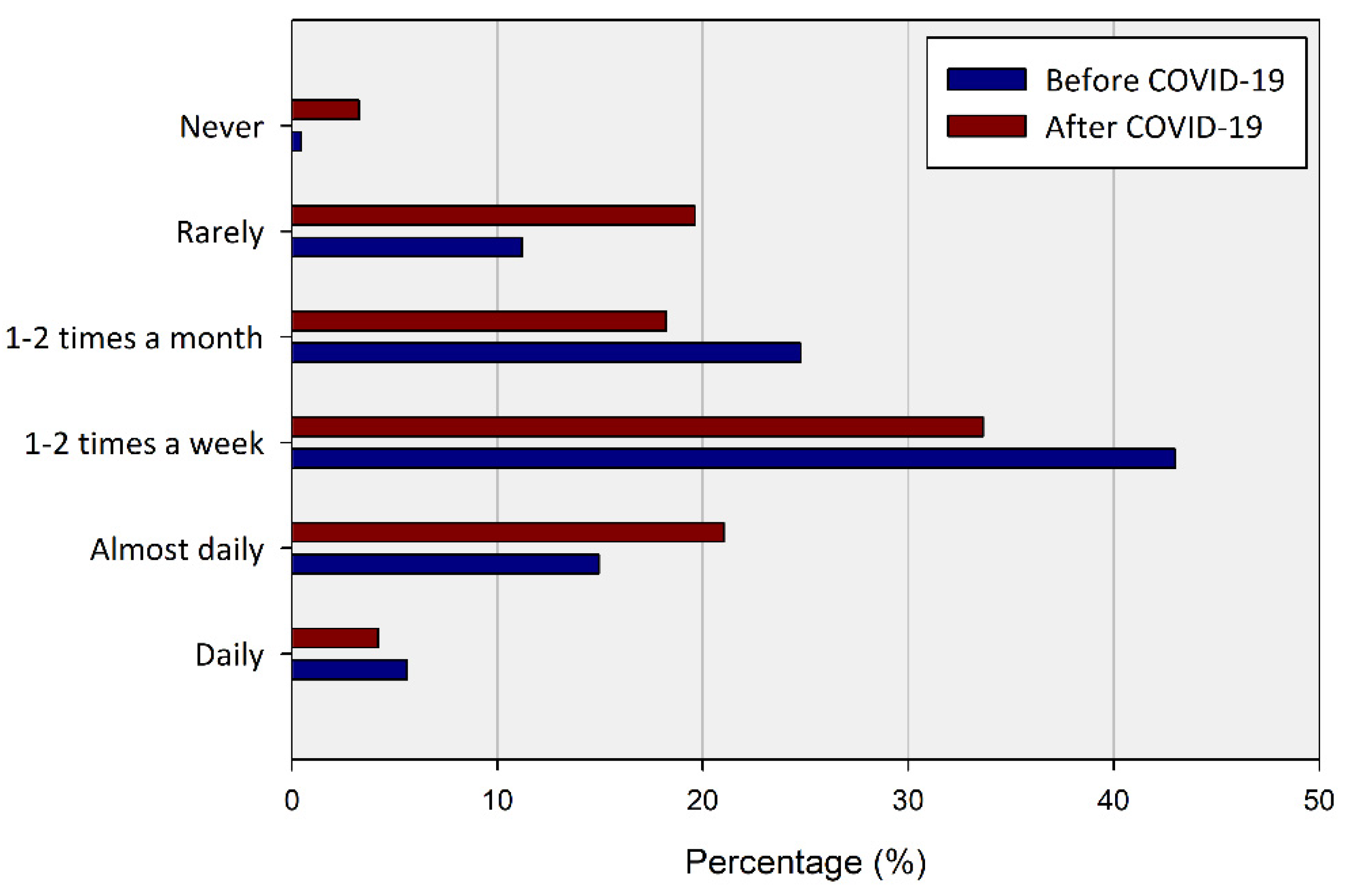

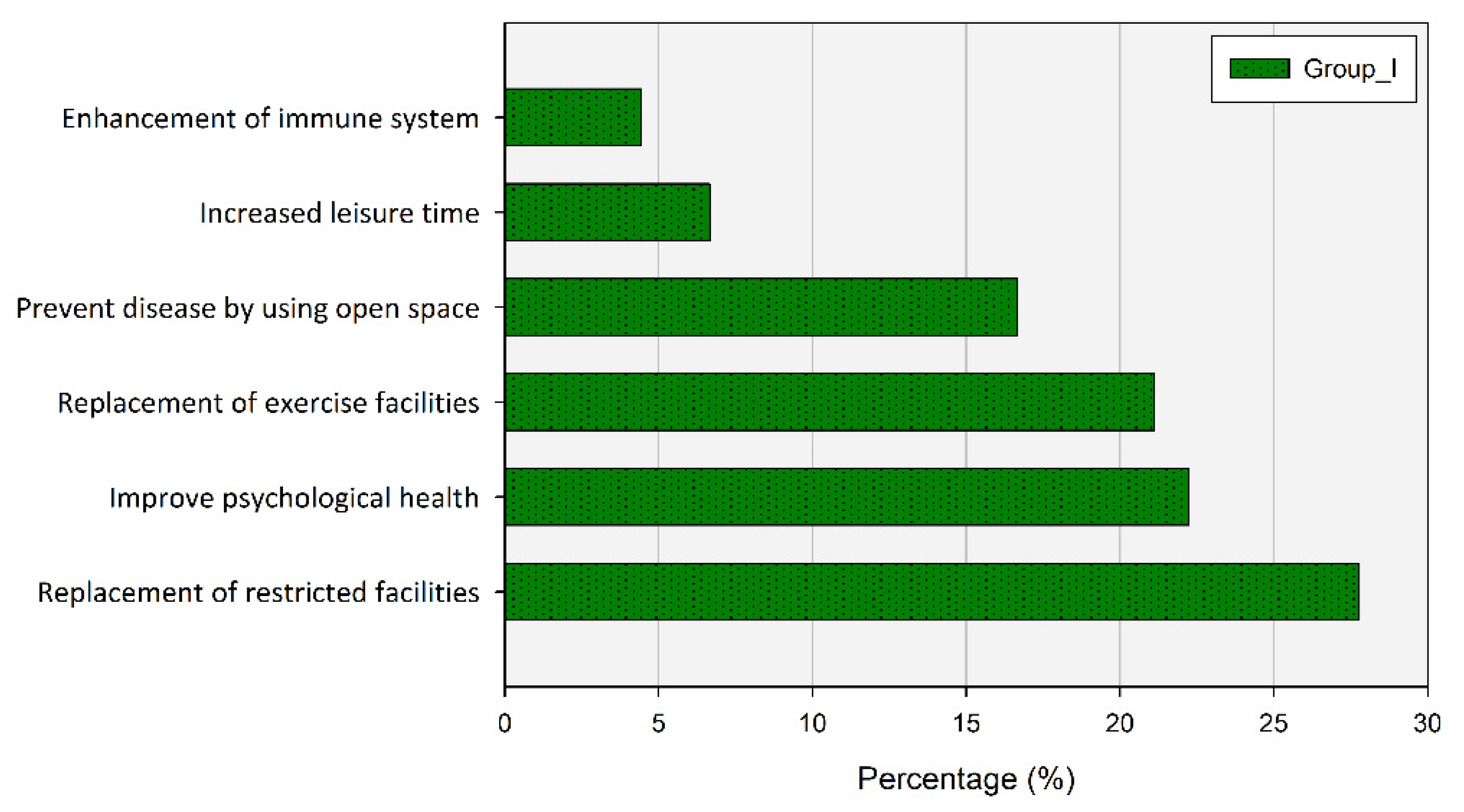
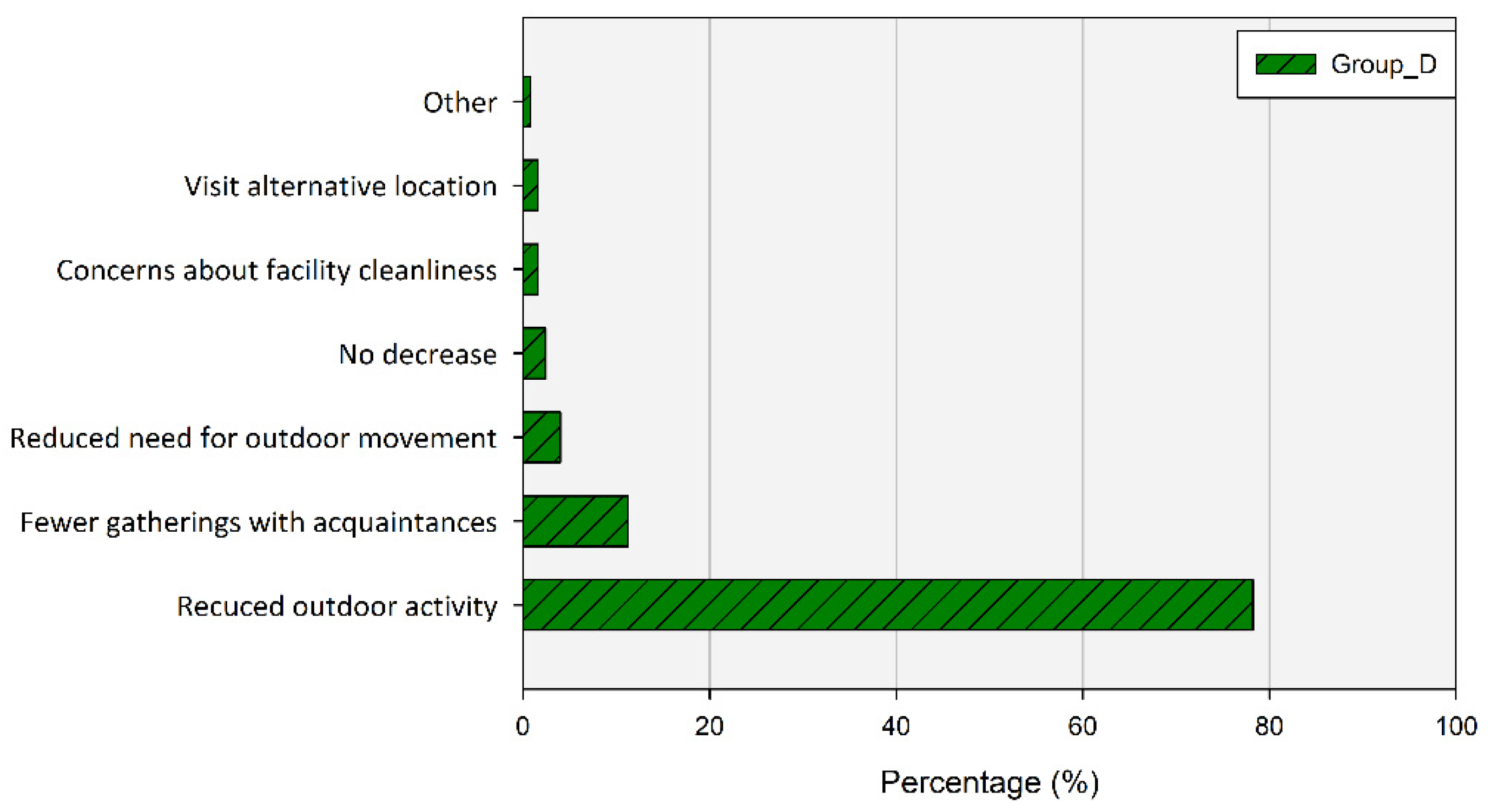

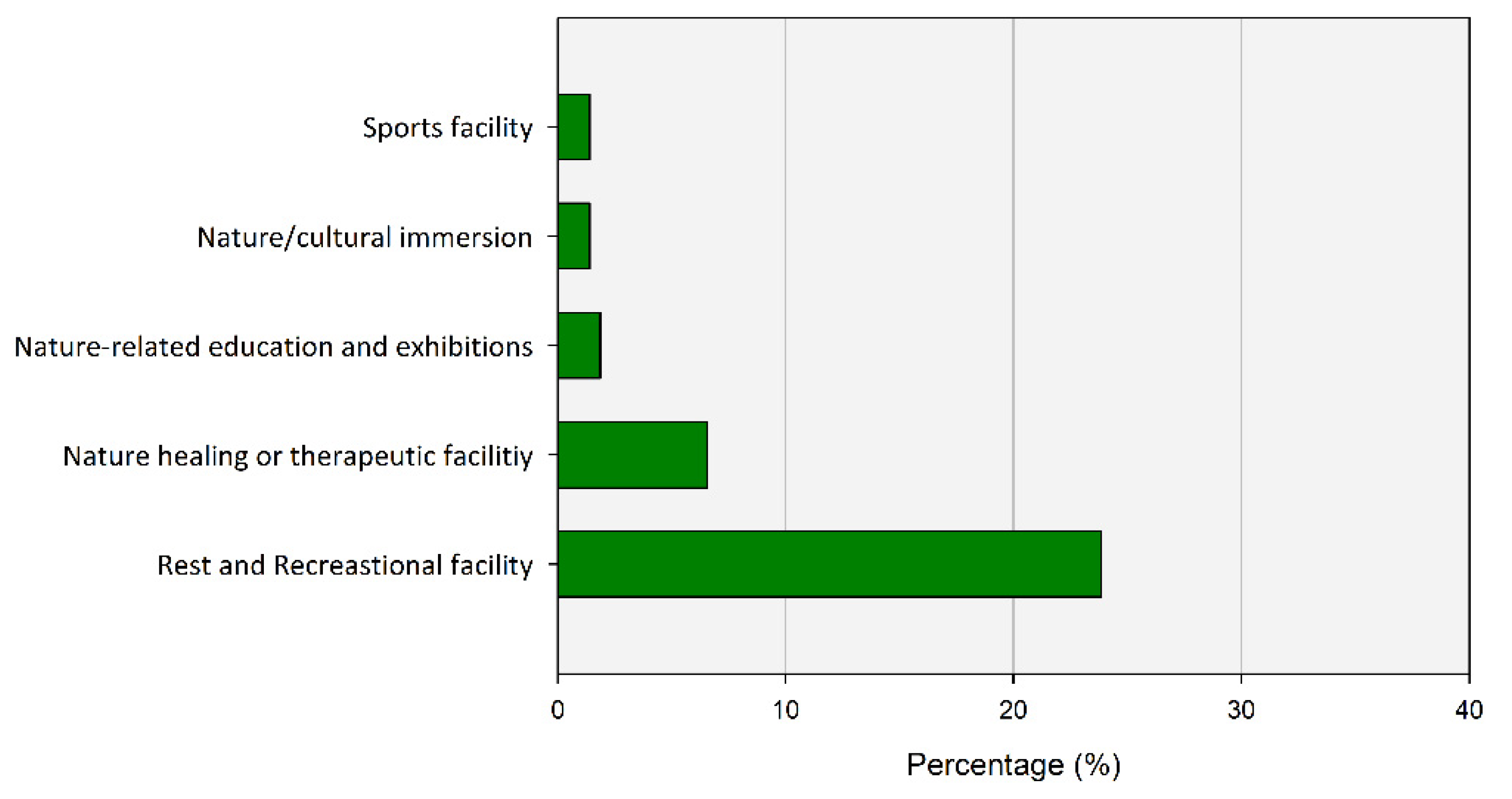
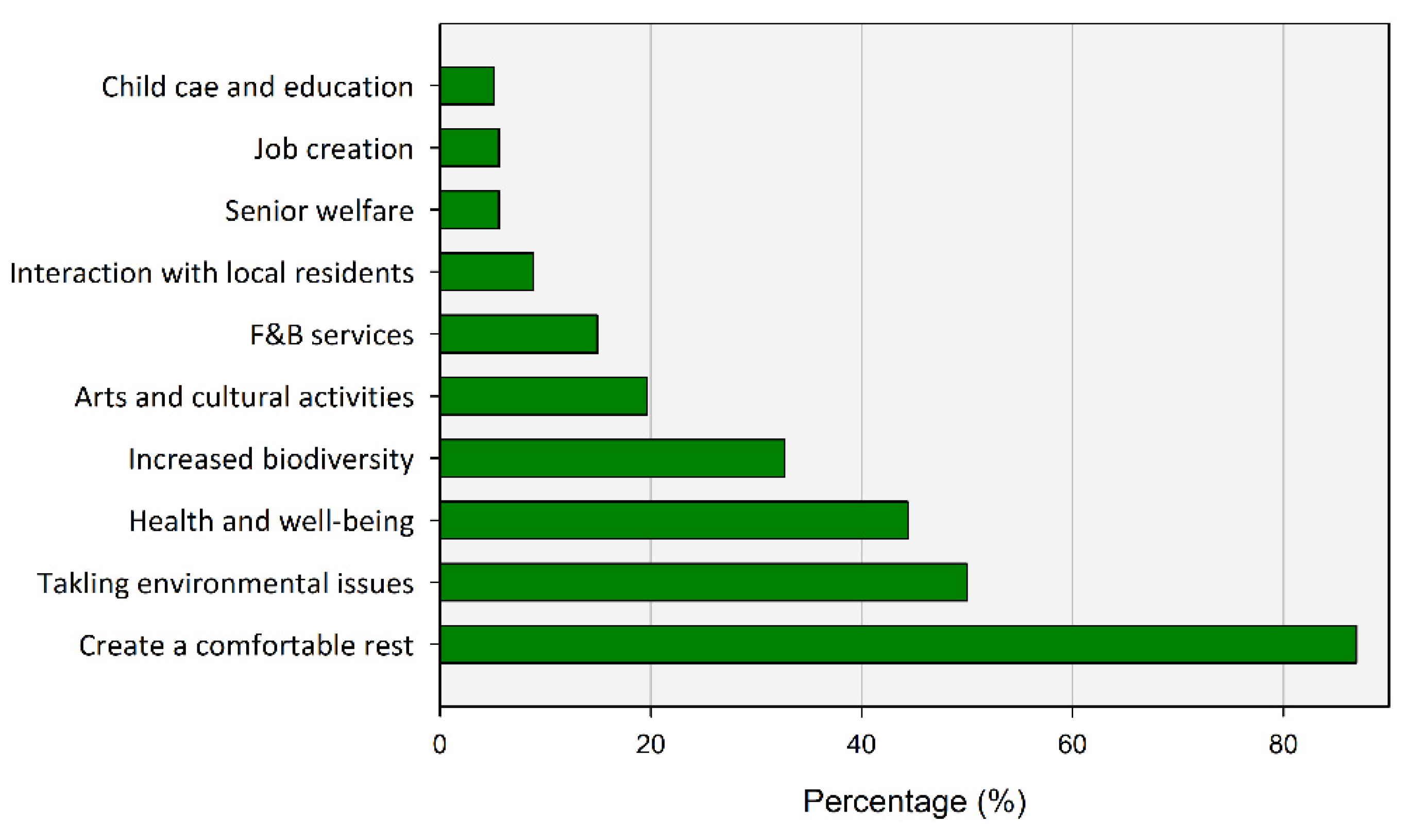
| Personal Characteristics | Frequency | Percentage (%) | |
|---|---|---|---|
| Gender | Male | 119 | 55.61 |
| Female | 95 | 44.39 | |
| Age | ~19 | 2 | 0.93 |
| 20~29 | 83 | 38.79 | |
| 30~39 | 44 | 20.56 | |
| 40~49 | 25 | 11.68 | |
| 50~59 | 42 | 19.63 | |
| 60~ | 18 | 8.41 | |
| Occupation | Student | 66 | 30.84 |
| Office worker | 60 | 28.04 | |
| Service worker | 12 | 5.61 | |
| Education | 6 | 2.80 | |
| Professional | 5 | 2.34 | |
| Technician | 41 | 19.16 | |
| Other | 8 | 3.74 | |
| Unemployed | 16 | 7.48 | |
| Workplace (n = 213) | Office | 117 | 52.80 |
| Home | 30 | 16.36 | |
| Combining office and home | 66 | 30.84 | |
| After COVID-19 | ||||||
|---|---|---|---|---|---|---|
| Very Important | Important | Neutral | Slightly Important | Not Important at All | ||
| Before COVID-19 | Very important | 73 | 2 | 2 | 0 | 0 |
| Important | 47 | 39 | 5 | 1 | 1 | |
| Neutral | 15 | 10 | 10 | 2 | 0 | |
| Slightly important | 2 | 3 | 0 | 2 | 0 | |
| Not important at all | 0 | 0 | 0 | 0 | 0 | |
| After COVID-19 | |||||||
|---|---|---|---|---|---|---|---|
| Daily | Almost Daily | 1–2 Times a week | 1–2 Times a Month | Rarely | Never | ||
| Before COVID-19 | Daily | 6 | 5 | 0 | 1 | 0 | 0 |
| Almost daily | 1 | 21 | 6 | 0 | 4 | 0 | |
| 1–2 times a week | 1 | 16 | 48 | 16 | 10 | 1 | |
| 1–2 times a month | 1 | 2 | 14 | 17 | 17 | 2 | |
| Rarely | 0 | 1 | 4 | 5 | 11 | 3 | |
| Never | 0 | 0 | 0 | 0 | 0 | 1 | |
Disclaimer/Publisher’s Note: The statements, opinions and data contained in all publications are solely those of the individual author(s) and contributor(s) and not of MDPI and/or the editor(s). MDPI and/or the editor(s) disclaim responsibility for any injury to people or property resulting from any ideas, methods, instructions or products referred to in the content. |
© 2023 by the authors. Licensee MDPI, Basel, Switzerland. This article is an open access article distributed under the terms and conditions of the Creative Commons Attribution (CC BY) license (https://creativecommons.org/licenses/by/4.0/).
Share and Cite
Kim, J.; Ko, Y.; Kim, W.; Kim, G.; Lee, J.; Eyman, O.T.G.; Chowdhury, S.; Adiwal, J.; Son, Y.; Lee, W.-K. Understanding the Impact of the COVID-19 Pandemic on the Perception and Use of Urban Green Spaces in Korea. Int. J. Environ. Res. Public Health 2023, 20, 3018. https://doi.org/10.3390/ijerph20043018
Kim J, Ko Y, Kim W, Kim G, Lee J, Eyman OTG, Chowdhury S, Adiwal J, Son Y, Lee W-K. Understanding the Impact of the COVID-19 Pandemic on the Perception and Use of Urban Green Spaces in Korea. International Journal of Environmental Research and Public Health. 2023; 20(4):3018. https://doi.org/10.3390/ijerph20043018
Chicago/Turabian StyleKim, Jiwon, Youngjin Ko, Whijin Kim, Gaeun Kim, Jeongmin Lee, Olebogeng Thelma G. Eyman, Sarwat Chowdhury, Julie Adiwal, Yowhan Son, and Woo-Kyun Lee. 2023. "Understanding the Impact of the COVID-19 Pandemic on the Perception and Use of Urban Green Spaces in Korea" International Journal of Environmental Research and Public Health 20, no. 4: 3018. https://doi.org/10.3390/ijerph20043018
APA StyleKim, J., Ko, Y., Kim, W., Kim, G., Lee, J., Eyman, O. T. G., Chowdhury, S., Adiwal, J., Son, Y., & Lee, W.-K. (2023). Understanding the Impact of the COVID-19 Pandemic on the Perception and Use of Urban Green Spaces in Korea. International Journal of Environmental Research and Public Health, 20(4), 3018. https://doi.org/10.3390/ijerph20043018








